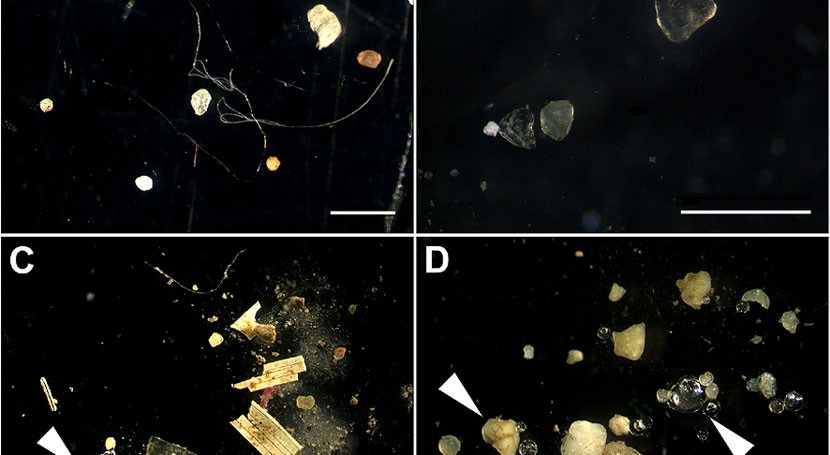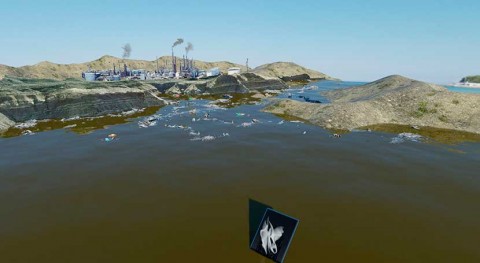Amid growing alarm over the plastic that pollutes our environment, biomedical and optics researchers at the University of Rochester are working to better understand the prevalence of microplastics in drinking water and their potential impacts on human health.
They are collaborating with SiMPore, a company that uses nanomembrane technology initially developed at the University, to devise ways to quickly filter and identify particles of plastic 5 mm or smaller in drinking water samples. They will then test the ability of these particles to cross a microscale barrier that simulates the lining of a human intestine.
“We want to see to what extent the particulates that you consume in your drinking water can pass through your gut and into your other organs,” says Greg Madejski, a postdoctoral fellow in the laboratory of James McGrath, professor of biomedical engineering. Madejski is coordinating the research with the lab of Wayne Knox, professor of optics. Both McGrath and Knox are affiliated with the Materials Science Program.
Microplastics are used as ingredients in cigarette filters, textile fibers, and cleaning or personal care products. Others result when larger plastic items are worn down by sun, wind, and waves. They can be found on mountaintops and at the bottom of the oceans; in the air we breathe and in the water we drink. Exactly how many microplastics are absorbed by humans, and how much harm it is causing them has been hard to assess because the particles— below 100 microns—are so small and difficult to detect.
“These are particles that you couldn’t pick up with tweezers; that you can’t even see with the naked eye,” Madejski says. They elude the “traditional method of skimming the surface of water with a plankton net and collecting everything,” he says.
Instead the researchers will filter water through sheets of silicon nitride a hundred times thinner than the diameter of a human hair. These SiMPore nanomembranes, based on prototypes initially created in the McGrath lab, have micron-sized slits in them. “That allows us to catch micron-sized debris,” Madejski says. “And because the sheets are so thin, you can filter a significant amount of water through them without a lot of pressure.”

The image at left shows debris captured on a silicon nanomembrane (greenish background, with bluish slots, 8 microns wide) by Greg Madejski in the lab of James McGrath. The fluorescence image at right shows how Nile red stain is used to identify the plastics. (McGrath lab photo)
The layer of microscopic debris that accumulates on the surface of the membranes is analyzed in various ways to determine how much of it consists of microplastic particles.
The particles can be stained with Nile Red dye, for example, which adheres to plastics. Raman microscopy, used in the Knox lab, shines a bright laser on the material to obtain chemical bond information—basically “a molecular fingerprint of what that material is,” Madejski says. “It doesn’t work as well with fluorescent material, which many plastics are, but it can clearly identify 10-micron polystyrene beads, for instance.”
The researchers also hope to use X-ray photoelectron spectroscopy and energy-dispersive X-ray spectroscopy techniques to further study the composition of microplastic particles.
“The beauty of nanoscale membranes is you can adapt them for a wide range of characterization tools,” Madejski says.
Particles that are identified as microplastics will be separated out and “fed” to Caco2 human epithelial cell lines that are widely used as a model of the intestinal epithelial barrier. This will help determine the extent to which the particles are absorbed into the body.
Working with David Rowley of the City of Rochester Water Bureau, water samples are being analyzed at every stage of the city’s 35-mile long gravity-fed water purification and supply system, which stretches from high elevation Hemlock Lake, where the city draws its water, through pipes and reservoirs, and ultimately reaching destinations like the drinking fountains and faucets in the labs and hallways of Goergen Hall on the University’s River Campus.
There is an urgency to learning more about the prevalence of microplastics and their potential impacts on human health, says Madejski, who recently attended a workshop on microplastics at the Woods Hole Oceanographic Institute.
“One thing to keep in mind is that over the last 70 years or so we’ve produced about 4 billion tons of plastic; in the next decade or so, we’re due to double that amount,” Madejski says.






